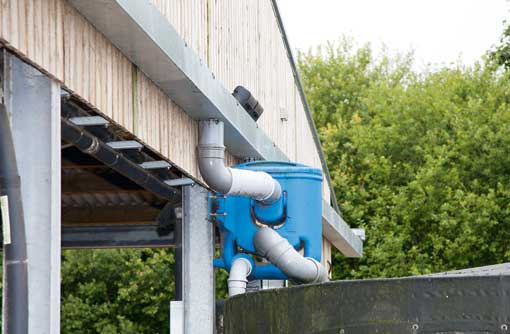Harvesting rainwater for spraying offers many benefits

Rainwater harvesting is nothing new and to design and construct a simple harvesting system is quick, easy and doesn’t have to cost the earth. But using it for spraying is becoming more popular with some growers even seeing benefits with efficacy of some actives.
“Making use of rainwater that falls on your buildings can save you money,” says Ian Barker, head of water at the Environmental Agency.
“It could mean potentially less storage for waste, and reduce the likelihood of contaminated run-off from yards entering streams and rivers.
Rainwater harvesting might not be suitable for everyone, but even if it cannot supply all your needs it’s still worth thinking about. It can help reduce costs and reduce your environmental impact.”
One such grower is Martin Hamilton, a Farmers Weekly Barometer Farmer in Co Down, Northern Ireland, who collects water to use in and around the Mash Direct business. Predominately its uses are to clean down areas inside and outside the buildings, but the real benefit he believes is in the application of crop protection chemicals.
The water is collected from four sheds measuring 36x30m and piped to a 15,000 litre-tank which sits behind the spray store. There is a basic filtering system that ensures leaves and any other debris are intercepted before entering the tank.
“I think everybody should be doing it, it’s so simple and straightforward. Even in an area of high rainfall like here, we have a responsibility to use water wisely. Many of the big retailers that we supply have a water management policy to ensure we use water responsibly.
“It is something I feel very bullish about because we know how severe the blight problem was last season. In a seriously difficult year, we believe that some of the success in controlling it had been down to using soft water,” says Mr Hamilton.
Lincolnshire grower Mark Pettit of WB Pettit & Son, Ferry Farm, Gainsborough, Lincolnshire, designed and built his own system to reduce water costs and his reliance on mains water. There are two farms in his village and if both farms are spraying simultaneously, the water pressure in the village can drop to an unacceptable level by 4pm.
So this March, Mr Pettit added an additional 20,000 litre-tank to bolster his existing 8,000-litre capacity. The new system collects rainwater from one half of his 24x20m grain store. “In a wet season like we have just had, we have collected just about enough water for all my spraying needs.
“The whole project took me about a week to install. I redirected the down pipes to feed the new tank and then dug a 50m long trench to connect the new tank with the existing tank. I fill my sprayer from the existing tank and when I need more water I just open a valve and the tank automatically fills up, it looks after itself.
Phase two at Ferry Farm, will be to install a similar tank to harvest rainwater from the other side of his grain store and then link the two tanks together. The water is not filtered going in to the tank and any sediment tends to sink to the bottom.
Tom Robinson, Syngenta application specialist, says most crop protection formulations can be used in a wide variety of “waters” with or without other substances without giving rise to much practical difficulty. However, occasionally problems can arise and when choosing water quality for spray mixes a number of factors need to be considered.
Cleanliness
Dirty water contaminated by particles of soil or organic matter should be avoided. Not only will the particles cause blockages within the sprayer, but these can deactivate some actives such as diquat.
pH
Acid waters are associated with upland areas on hard rock with peat, or localised lowland peat soils. Growers should be aware that pH can even change during the day depending on the methods used by the water companies to adjust pH and manage water quality. Some actives are considerably less stable in slightly alkaline solutions than slightly acidic ones and this is why some manufacturers have in the past sold buffering agents to maintain the pH at 5.0.
Hardness
This is a measure of mineral load, mostly affected by the presence of calcium or magnesium. However, the presence of manganese or iron can also affect water hardness. It varies around the country with limestone and chalk areas proving to be the hardest.
Calcium and iron in the water can deactivate certain pesticides, especially glyphosate and sulfonylureas. In very hard areas simply add ammonium sulphate such as AS Elite.
“As a general rule harvested water will be the best choice for applying crop protection products, with but there are always a few instances where this is not the case,” says Mr Robinson.
Calculating likely rainwater yield |
|---|
| Assumptions |
Using a 40x20m grain store = an area of 800sq m |
Run off coefficient (ROC) for pitched roof is 0.85* |
Filter efficiency (FE) is about 80% – so multiply by 0.8 |
Area (800sq m) x ROC (0.85) x FE (0.8) x Annual rainfall (700mm) = 380,800 litres |
*Run off coefficient: |
| Pitched roof multiply by 0.85 |
| Flat roof gravel surface multiply by 0.45 |
| Flat roof smooth surface multiply by 0.5 |
More from Crops
Subscribe and get your own copy of the magazine
